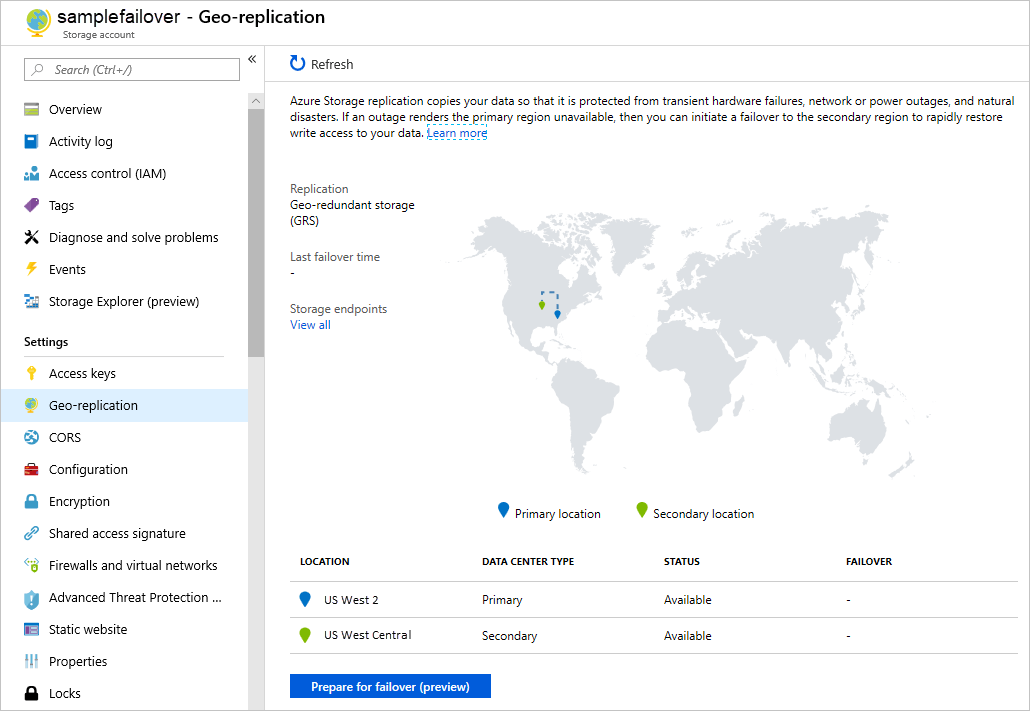Microsoft Azure launched the preview for storage accounts failover for patrons with geo-redundant storage (GRS). There has at all times been a necessity to have the ability to decide when a storage account write entry is required and the secondary replication state is known. This performance permits making the most of controlling when to failover from the first area to the secondary area for the storage account.
Specifically, if the first area for a geo-redundant storage account turns into unavailable for some purpose, it’s now potential to finish an account failover. Each time a failover is carried out, all information within the storage account fails over to the secondary area making it the brand new major area. All of the DNS information for all storage endpoints get up to date to level to the brand new major area. As quickly because the failover is full it’s potential to routinely start writing information utilizing the endpoints within the new major area.
The beneath diagram shows a traditional failover workflow. That’s when a shopper writes information to geo-redundant storage (GRS or RA-GRS) within the major area and the information is asynchronously replicated to the secondary area. If the write requests fail inside a while one can set off the failover.


Upon completion of the failover, write operations are resumed utilizing the brand new major service endpoints. After the failover, the storage is configured as domestically redundant (LRS). Thus the account must be re-configured as geo-redundant storage (RA-GRS or GRS) to renew replication to the brand new secondary area. Changing a locally-redundant (LRS) account to RA-GRS or GRS incurs a price.
All new and present Azure Useful resource Supervisor storage accounts which can be configured for RA-GRS and GRS assist the preview of account failover. Storage accounts supported are general-purpose v1 (GPv1), general-purpose v2 (GPv2), or Blob Storage accounts in US-West 2 and US-West Central.
Account failover may be initiated from the Azure portal, Azure PowerShell, Azure CLI, or the Azure Storage Resource Provider API. The beneath screenshot reveals one-step initiation of an account failover from inside the Azure portal.


Being presently in preview, account failover shouldn’t be used with manufacturing workloads as there is no such thing as a manufacturing SLA accessible till this characteristic turns into usually accessible.
Necessary be aware: account failover typically leads to some information loss as a result of geo-replication latency concerned. Whereas the secondary endpoint is often behind the first endpoint, any information that has not but been replicated to the secondary area will likely be misplaced after the failover.
It is suggested to test the Final Sync Time property earlier than initiating a failover to guage how far the secondary endpoint is behind the first. Study extra concerning the account failover options and implications within the documentation “What to do if an Azure Storage outage occurs”.
Specifically, if the first area for a geo-redundant storage account turns into unavailable for some purpose, it’s now potential to finish an account failover. Each time a failover is carried out, all information within the storage account fails over to the secondary area making it the brand new major area. All of the DNS information for all storage endpoints get up to date to level to the brand new major area. As quickly because the failover is full it’s potential to routinely start writing information utilizing the endpoints within the new major area.
The beneath diagram shows a traditional failover workflow. That’s when a shopper writes information to geo-redundant storage (GRS or RA-GRS) within the major area and the information is asynchronously replicated to the secondary area. If the write requests fail inside a while one can set off the failover.


Upon completion of the failover, write operations are resumed utilizing the brand new major service endpoints. After the failover, the storage is configured as domestically redundant (LRS). Thus the account must be re-configured as geo-redundant storage (RA-GRS or GRS) to renew replication to the brand new secondary area. Changing a locally-redundant (LRS) account to RA-GRS or GRS incurs a price.
Find out how to get began with an account failover
All new and present Azure Useful resource Supervisor storage accounts which can be configured for RA-GRS and GRS assist the preview of account failover. Storage accounts supported are general-purpose v1 (GPv1), general-purpose v2 (GPv2), or Blob Storage accounts in US-West 2 and US-West Central.
Account failover may be initiated from the Azure portal, Azure PowerShell, Azure CLI, or the Azure Storage Resource Provider API. The beneath screenshot reveals one-step initiation of an account failover from inside the Azure portal.


Being presently in preview, account failover shouldn’t be used with manufacturing workloads as there is no such thing as a manufacturing SLA accessible till this characteristic turns into usually accessible.
Necessary be aware: account failover typically leads to some information loss as a result of geo-replication latency concerned. Whereas the secondary endpoint is often behind the first endpoint, any information that has not but been replicated to the secondary area will likely be misplaced after the failover.
It is suggested to test the Final Sync Time property earlier than initiating a failover to guage how far the secondary endpoint is behind the first. Study extra concerning the account failover options and implications within the documentation “What to do if an Azure Storage outage occurs”.
